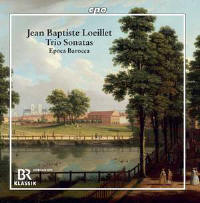Texte paru dans: / Appeared in: |
|
|
Outil de traduction ~ (Très approximatif) |
|
|
Reviewer: Raymond
Tuttle
I do not know if this is the
first CD to offer such a generous sampling of Jean Baptiste Loeillet’s trio
sonatas, but it is the only one currently available through Presto Classical
and ArkivMusic. Fortunately, the performances are very good, and leave me,
if not hungry for more, at least receptive to that idea. There is a lot of confusion surrounding this composer. There are several composers from the late 1600s and early 1700s who had this name, or some close variation thereof, or whose music was published under the Loeillet name. The one represented on this CD is the Jean Baptiste (sometimes hyphenated) Loeillet who was born in 1680 and died in 1730, and who was known as “Jean(-)Baptiste Loeillet of London,” for the city in which he spent the latter part of his life. His works were published there by John Walsh under the name “John Loeillet,” and his family name sometimes was rendered as “Lully.” His first cousin was Jean(-)Baptiste Loeillet of Ghent” (or “Gant”), and he had a brother named Jacques Loeillet. Confused yet? It’s as clear as mud! Luckily, his music is as cloudy as crystal. Loeillet of London’s opus 1 (published in 1722) is a set of six trio sonatas—three for flute and oboe (or violin), and three for two transverse flutes. On this recording, two are played by recorder and oboe, and one (Sonata No. 5) is played by transverse flute and oboe. Three years later, Loeillet and Walsh doubled London’s pleasure and doubled its fun by releasing a set of 12 trio sonatas—six for two violins, three for two transverse flutes, and three for flute and oboe. Again, on this recording, two are played by recorder and oboe, and one (Sonata No. 4) is played by transverse flute and oboe. In Epoca Barocca, the flute and the recorder are played by Eva Morsbach and the oboe by Alessandro Piqué. The basso continuo players are Katrin Lazar (bassoon—delightfully prominent!), Klaus Dieter Brandt (cello), Daniele Caminiti (theorbo), and Andrea Perugi (harpsichord and organ). All six sonatas presented here are in the sonata da chiesa format (slow-fast-slow-fast), although two of the sonatas have one tripartite movement that effectively increases the number of movements in those sonatas to six. Despite Loeillet’s Flemish heritage, the trio sonatas owe more to the Italians. Indeed, it was Loeillet who introduced Corelli’s concerti grossi to London. I can understand why these works were so popular in London. Loeillet’s fame was made as a keyboard player, yet he understood wind instruments very well: the dialogues between the flute (or recorder) and the oboe are piquant, and tinged with an appealing melancholy when the key is minor—for example, in the lovely Sonata No. 4 from op. 2. The opening Largo sighs but never wilts, and it is followed by an Allegro in which the two wind instruments play whack-a-mole together. The third movement is an Adagio, just one minute in length, and in it, the transverse flute and the oboe engage in close harmony. The second and final Allegro has both dignity and charm. Morsbach and Piqué are both well matched and well balanced, and no one puts a foot wrong anywhere in this recital. The recording, by Bavarian Radio, dates from 2017. This CD adds to an already fairly long list of successful CDs by Epoca Barocca.
| |
|
|
|
|
Cliquez l'un ou l'autre
bouton pour découvrir bien d'autres critiques de CD |
|




